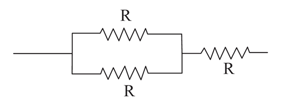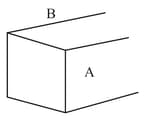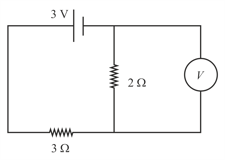Ohm's Law
Ohm's Law: Overview
This Topic covers sub-topics such as Ohm's Law, Electric Circuit, Drift Velocity, Relation between Drift Velocity and Electric Current, Mobility of Electron, Ohm's Law in Vector Form, Ohmic Resistance, Non Ohmic Resistance and, Relaxation Time of Electron
Important Questions on Ohm's Law
A wire of resistance is gradually stretched to double its original length. It is then cut into two equal parts. These parts are then connected in parallel across a battery. Find the current drawn from the battery.
A physical quantity, associated with electrical conductivity, has the SI unit ohm-meter. Identify this physical quantity.
Two conducting wires X and Y of same diameter but different materials are joined in series across a battery. If the number density of electrons in X is twice that in Y, find the ratio of drift velocity of electrons in the two wires would be:
Derive an expression for the resistivity of a good conductor, in terms of the relaxation time of electrons.
The number density of free electrons in a copper conductor is How long does an electron take drift from one end of a wire 3.0 m long to its other end? The area of cross-section of the wire is and is carrying a current of 3.0 A.
A voltage of is applied across a carbon resistor with first, second and third rings of blue, black and yellow colours respectively. Calculate the value of current, in , through the resistor.
The number density of free electrons in a copper conductor is estimated at How long does an electron take to drift from one end of a wire 3.0 m long to its other end? The area of cross-section of the wire is and it is carrying a current of 3.0 A.
The relation between current and drift velocity is
Two wires of same material and same length have their resistances in the ratio, the ratio of the masses of the wires is
What is the total resistance in the following circuit element?

In an electric circuit, a wire of resistance is used. If this wire is stretched to a length double of its original value, the current in the circuit would become :
The r.m.s, potential difference between the red live wire and a black neutral wire in Indian domestic electric supply is:
A wire of resistance is melted and drawn in a wire of one-fourth of its length. The new resistance of the wire will be
A rectangular parallelopiped is measured as . If its specific resistance is , then the resistance between its two opposite rectangular faces will be _____.

The length of a conductor having resistance , is compressed to of its initial value. The new resistance will be
In the circuit shown reading of the ideal voltmeter used is equal to _____ volts.

If the length of a conductor is increased by percent and cross-sectional area is decreased by percent, then calculate the percentage change in the resistance of the conductor.
A hollow cylindrical conductor has length of while its inner and outer diameters are and respectively. The resistance of the conductor is . If the resistivity of the material is . The value of is
A copper wire of length and radius () has electrical resistance of . The current density in the wire for an electric field strength of is:
What equal length of an iron wire and copper nickel alloy wire, each of diameter connected parallel to give an equivalent resistance of ?
